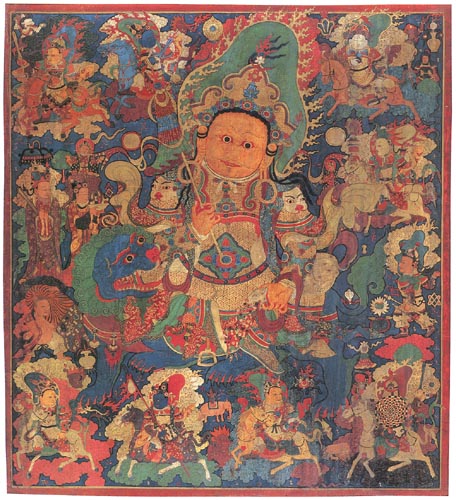| 53. Vaishravana
|

53.
Vaishravana
Central Tibet, ca.
first half of the 15th century
Distemper on linen
81.3 x 74 cm (32 x 291/8 in.)
Private collection
|
This glorious, richly patterned painting depicts Vaishravana, guardian (lokapala) of the north and bestower of wealth, who is surrounded by members of his celestial army as he straddles a blue snow lion. This ancient Indian god assumed many iconographical forms that incorporated elements from various local traditions, since he was worshiped in India, China, and Central Asia before becoming popular in Tibet. Giuseppe Tucci argues, for example, that Vaishravana's hat was modeled on the crowns worn by Sassanian kings, and his armor reflects Iranian design.1 Here, Vaishravana appears as King of the Horses - one of four mythic kings (caturmaharaja) - who rules over the northern quadrant of the earth, a role in which he also serves as protector of the Buddhist faith (dharmapala).
Tucci, who first published this painting in 1949, noted that in 742 the Indian Buddhist monk
Amoghavajra
invoked Vaishravana for protection in China as invading Tibetan, Arab, and Sogdian armies attacked the city of
Anxi (Xinjiang).2 His prayers were answered when "... a fearful army suddenly appearing amid a great earthquake
put the enemy's troops to flight and delivered the city."3 A Tibetan account of the origins of the noble Chongye
family includes a similar story in which an eighth-century Tibetan prince led his army against China, protected by
Vaishravana and his eight horsemen, who were depicted on flags carried into battle by the victorious Tibetan
army.4
Dressed in the garb of a mythic warrior-king, Vaishravana wears heavy, highly ornamental armor with lion heads acting as lappets; the sleeves of his upper garment flutter as though moved by the wind, revealing armor-covered lower arms. He holds a victory banner (dhvaja) and, tucked under his left arm, a mongoose spitting gems. Another costume, consisting of a richly patterned textile, falls over his saddled snow-lion mount. Vaishravana's long dark tresses wrap around his upper ears and then fall onto his shoulders and upper torso.
He is accompanied by the Eight Lords of the Horses (ashvapati). Each is associated with a color, a symbol, and
a point of the compass: Jambhala (white, three jewels,5 the east), Purnabhadra (yellow, a vase, the south),
Manibhadra (yellow, a gem, the west), Kubera (yellow, a sword, the north), Samjneya (white, a knife, the southeast),
Atavaka (blue, a spear, the southwest), Panchika (yellow, a pavilion, the northwest), and Bijakundalin (blue, a sword, the northeast).6 Each rides on storm clouds and they are accompanied by members of their demon armies. They and their steeds twist and turn in space, their fiery halos distorted as if blown by a ferocious wind.7 Other figures, unidentified but clearly associated with Vaishravana's myth, include a portly figure carrying a striped sack on his shoulder, from which he pours gems and auspicious symbols, and a warrior on foot carrying a ritual staff.
The identities of the kingly figure grasping a sword and the adjacent, regally clad woman with an offering bowl have been the subject of much debate. Tucci believed them to be the king and queen of the
nagas
(serpent deities), who, having been conquered by Vaishravana, offer obeisance to
him.8 More recently,
Franco Ricca and Erberto Lo Bue have suggested that these two figures represent the Indian goddess Lakshmi
and Pulastya, Vaishravana's father or grandfather, who lent his army to help Vaishravana in his battle against the nagas.9 Gilles
Béguin and Sylvie Colinart have analyzed
various hypotheses about the identities of these figures in Vaishravana paintings from Dunhuang and elsewhere,
pointing out the difficulties in all interpretations thus far proffered.10 Future research may clarify the identities of
these figures, who long ago became part of Vaishravana's iconography. Surrounding these richly detailed figures are the eight auspicious Buddhist symbols and the seven treasures of the chakravartin.
Vaishravana appears in the early-fourteenth-century murals at Shalu and in the century-later murals of the Gyantse Kumbum.11 Although many iconographic elements of this painting appear in the Shalu Vaishravana
(the cap style, armor, and blue snow-lion mount), this work is closer in style to the Gyantse murals, with which it shares close physiognomic similarities, rich textile designs, and similarly characterized horsemen whose fiery halos also assume a windblown flutter. This work is unusual in that it is painted on red linen (see Bruce-Gardner, essay, below), and its consecratory mantras are painted in gold on the front of the painting, beneath Vaishravana and his army,
indicating the powerful role such mantras were thought to play even when unseen.
JCS
1. Tucci 1949,
vol. 2, pp. 573-74. See also Lo Bue and Ricca
1990, pp. 39-42. [back]
2. Ibid., vol. 2, p. 573. [back]
3. Ibid. [back]
4. Ibid., vol. 2, pp. 574, 734-35. Béguin and Colinart (1994, p. 140)
ascribe this Tibetan account to the late fourteenth century, but Tucci's translation of the Fifth Dalai Lama's Chronicles places
the story during the time of Padmasambhava, the eighth-century Indian Buddhist master.
[back]
5. Jambhala's identifying symbol is presented here as a tripartite blue gem.
[back]
6. Traditional names and identifying attributes vary for this group;
this list follows that cited in Béguin and Colinart 1994, analyzing a similar painting in the
Musée Guimet; see cat. no. 52. [back]
7. Very similar windblown flaming halos appear in
thirteenth-fourteenth century Taoist murals at the Yongle Palace; see Liao Ping 1985, pls. 30, 31
[back]
8. Tucci 1949, vol. 2, p. 575. [back]
9. Ricca and Lo Bue 1993, pp. 93-94. [back]
10. Béguin and Colinart 1994, pp.142-43. [back]
11. Vitali 1990, pl. 49; Ricca and Lo Bue 1993, pls. 71-73. [back]
|
